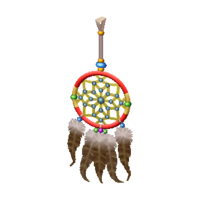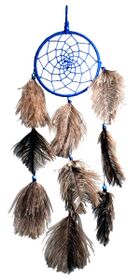Dream catcher (New Leaf)
| ||||||||
 | ||||||||
| Buy price | Sell price | |||||||
|---|---|---|---|---|---|---|---|---|
| Size | ||||||||
| Obtain via | ||||||||
| Customize | No customization options. | |||||||
| Rarity group | None | |||||||
| HHA theme challenges | Toy shop | |||||||
| HHA points | 1051 | |||||||
| HHA penalty if facing wall | No | |||||||
| Style | Iconic | |||||||
| Colors | ||||||||
| Internal information | ||||||||
Filename: int_jhn_dreamcatcherInternal ID:
2D80 | ||||||||
| Variations | ||||||||
None
| ||||||||
Names in other languages
ドリームキャッチャー
N/A attrapeur de rêves atrapasueños acchiappasogni N/A
드림 캐처 N/A attrapeur de rêves atrapasueños Traumfänger N/A | ||||||||
The dream catcher is a wall-mounted furniture item in Animal Crossing: New Leaf.
The dream catcher can be obtained in a letter from Gulliver after the player speaks to him and answers with the correct location.
No villagers have this item in their home, nor do any characters have this item in their RV.
Real-world information
Asabikeshiinh, translated as "spider" in Ojibwe, or commonly known as a dreamcatcher, is a spider-web like hoop ornament made of willow, and decorated with sacred items, such as feathers and beads. The dreamcatcher originates from the Ojibwe nation as a way to protect infants with a special charm in part due to the wide distribution of the Ojibwe at the time.
In recent years however, the dreamcatcher has also become symbolic of the Pan-Native American movements in Canada and the United States, and has become popularized by the 1990s. However, its popularity resulted in increased commercialized of the item, creating skepticism among Native American groups due to their inauthenticity to Native culture.[1] More information on this topic is available at Wikipedia.
Notes
- ↑ Re-Tail sell price; can be sold for 80% of this price (
 320 Bells) at Timmy and Tommy's store
320 Bells) at Timmy and Tommy's store
- ↑ Filly and Holden cannot legitimately move to the player's town via normal gameplay, but a default house layout can be observed via hacking. They share the same housing layout.
References
- Includes data sourced from the ACNL Spreadsheet project (Spreadsheet - Translations)
- ↑ "Native American Dreamcatchers: Ojibwe and other Indian dream-catcher crafts". Native American Language Net. Retrieved January 4, 2022.
